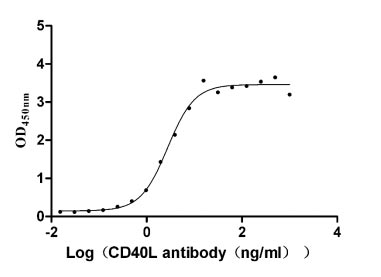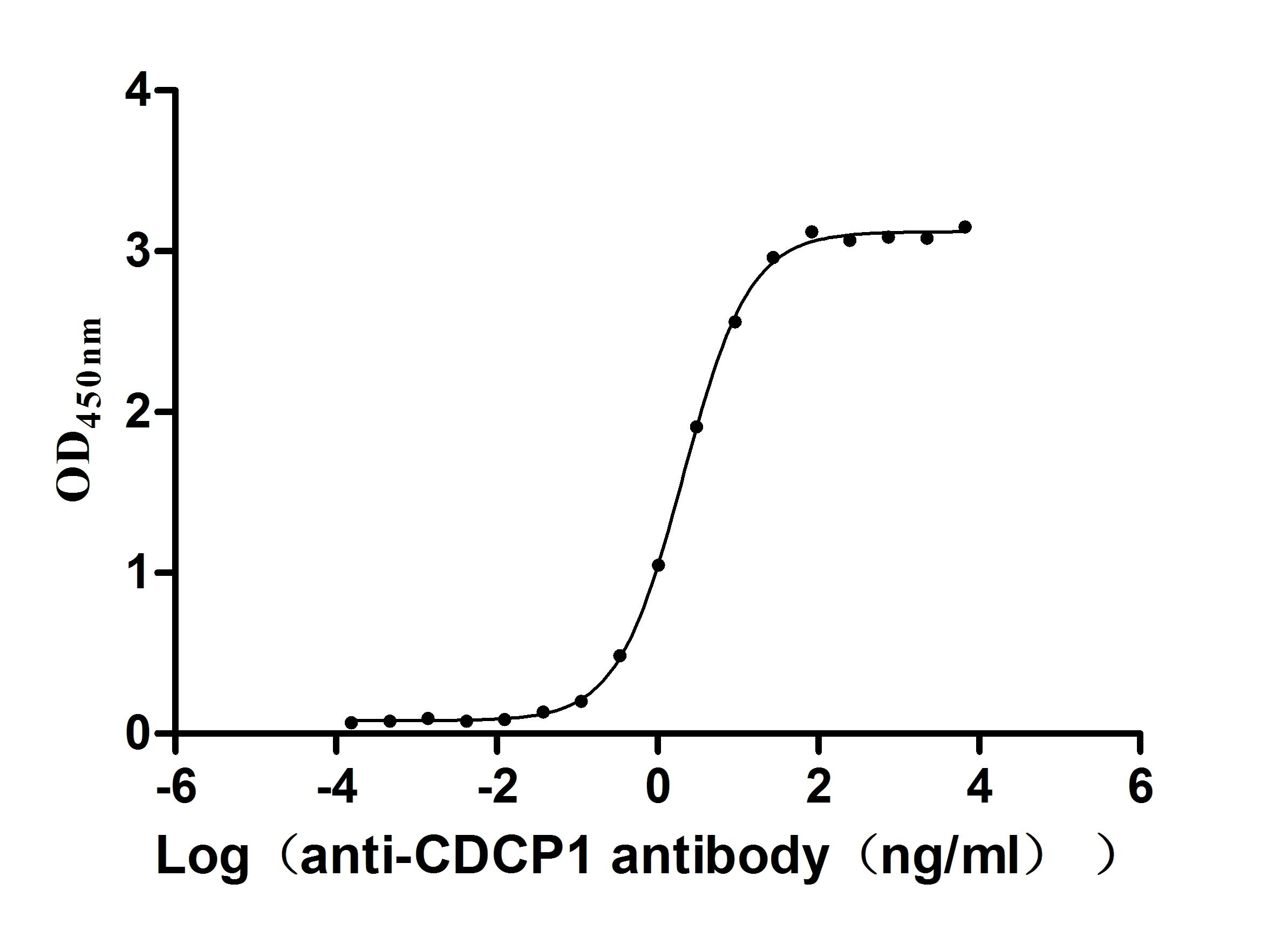Recombinant Human Nucleolar protein 56 (NOP56)
-
货号:CSB-YP015939HU
-
规格:
-
来源:Yeast
-
其他:
-
货号:CSB-EP015939HU
-
规格:
-
来源:E.coli
-
其他:
-
货号:CSB-EP015939HU-B
-
规格:
-
来源:E.coli
-
共轭:Avi-tag Biotinylated
E. coli biotin ligase (BirA) is highly specific in covalently attaching biotin to the 15 amino acid AviTag peptide. This recombinant protein was biotinylated in vivo by AviTag-BirA technology, which method is BriA catalyzes amide linkage between the biotin and the specific lysine of the AviTag.
-
其他:
-
货号:CSB-BP015939HU
-
规格:
-
来源:Baculovirus
-
其他:
-
货号:CSB-MP015939HU
-
规格:
-
来源:Mammalian cell
-
其他:
产品详情
-
纯度:>85% (SDS-PAGE)
-
基因名:NOP56
-
Uniprot No.:
-
别名:NOP56; NOL5ANucleolar protein 56; Nucleolar protein 5A
-
种属:Homo sapiens (Human)
-
蛋白长度:full length protein
-
表达区域:1-594
-
氨基酸序列MVLLHVLFEH AVGYALLALK EVEEISLLQP QVEESVLNLG KFHSIVRLVA FCPFASSQVA LENANAVSEG VVHEDLRLLL ETHLPSKKKK VLLGVGDPKI GAAIQEELGY NCQTGGVIAE ILRGVRLHFH NLVKGLTDLS ACKAQLGLGH SYSRAKVKFN VNRVDNMIIQ SISLLDQLDK DINTFSMRVR EWYGYHFPEL VKIINDNATY CRLAQFIGNR RELNEDKLEK LEELTMDGAK AKAILDASRS SMGMDISAID LINIESFSSR VVSLSEYRQS LHTYLRSKMS QVAPSLSALI GEAVGARLIA HAGSLTNLAK YPASTVQILG AEKALFRALK TRGNTPKYGL IFHSTFIGRA AAKNKGRISR YLANKCSIAS RIDCFSEVPT SVFGEKLREQ VEERLSFYET GEIPRKNLDV MKEAMVQAEE AAAEITRKLE KQEKKRLKKE KKRLAALALA SSENSSSTPE ECEEMSEKPK KKKKQKPQEV PQENGMEDPS ISFSKPKKKK SFSKEELMSS DLEETAGSTS IPKRKKSTPK EETVNDPEEA GHRSGSKKKR KFSKEEPVSS GPEEAVGKSS SKKKKKFHKA SQED
-
蛋白标签:Tag type will be determined during the manufacturing process.
The tag type will be determined during production process. If you have specified tag type, please tell us and we will develop the specified tag preferentially. -
产品提供形式:Lyophilized powder
Note: We will preferentially ship the format that we have in stock, however, if you have any special requirement for the format, please remark your requirement when placing the order, we will prepare according to your demand. -
复溶:We recommend that this vial be briefly centrifuged prior to opening to bring the contents to the bottom. Please reconstitute protein in deionized sterile water to a concentration of 0.1-1.0 mg/mL.We recommend to add 5-50% of glycerol (final concentration) and aliquot for long-term storage at -20℃/-80℃. Our default final concentration of glycerol is 50%. Customers could use it as reference.
-
储存条件:Store at -20°C/-80°C upon receipt, aliquoting is necessary for mutiple use. Avoid repeated freeze-thaw cycles.
-
保质期:The shelf life is related to many factors, storage state, buffer ingredients, storage temperature and the stability of the protein itself.
Generally, the shelf life of liquid form is 6 months at -20°C/-80°C. The shelf life of lyophilized form is 12 months at -20°C/-80°C. -
货期:Delivery time may differ from different purchasing way or location, please kindly consult your local distributors for specific delivery time.Note: All of our proteins are default shipped with normal blue ice packs, if you request to ship with dry ice, please communicate with us in advance and extra fees will be charged.
-
注意事项:Repeated freezing and thawing is not recommended. Store working aliquots at 4°C for up to one week.
-
Datasheet :Please contact us to get it.
相关产品
靶点详情
-
功能:Involved in the early to middle stages of 60S ribosomal subunit biogenesis. Core component of box C/D small nucleolar ribonucleoprotein (snoRNP) particles. Required for the biogenesis of box C/D snoRNAs such U3, U8 and U14 snoRNAs.
-
基因功能参考文献:
- Genetic and clinical analysis of spinocerebellar ataxia type 36 in Mainland China, with its causative mutation as a hexanucleotide GGCCTG repeat expansion in intron 1 of the NOP56 gene, has been described. PMID: 26661328
- Studies indicate that the causative mutation for spinocerebellar ataxias SCA36, namely intronic hexanucleotide GGCCTG expansion in NOP56 gene, has been identified. PMID: 26663071
- We newly found intronic hexanucleotide GGCCTG gene expansion in NOP56 gene as the causative mutation in nine unrelated Japanese familial hereditary spinocerebellar ataxia patients PMID: 22353375
- This study demonistrated that NOP56 mutation is response spinocerebellar ataxia 36 in Spainish family. PMID: 22492559
- Expansion of the intronic GGCCTG hexanucleotide repeat in NOP56 causes a unique form of spinocerebellar ataxias, SCA36, which shows not only ataxia but also motor neuron dysfunction. PMID: 21683323
- hNop56p functions in the early to middle stages of 60 S subunit synthesis in human cells and has functional similarities with treacle-associated ribonucleoproteins PMID: 12777385
- Data demonstrate that fibrillarin and Nop56 directly interact in vivo, and that this interaction is indispensable for the association of both proteins with the box C/D snoRNPs. PMID: 19331828
- snoRNP assembly factor NUFIP can regulate the interactions between TIP48 and TIP49 and the core box C/D proteins. PMID: 19620283
显示更多
收起更多
-
相关疾病:Spinocerebellar ataxia 36 (SCA36)
-
亚细胞定位:Nucleus, nucleolus. Cytoplasm. Nucleus, nucleoplasm.
-
蛋白家族:NOP5/NOP56 family
-
数据库链接:
HGNC: 15911
OMIM: 614153
KEGG: hsa:10528
STRING: 9606.ENSP00000370589
UniGene: Hs.376064
Most popular with customers
-
Recombinant Human CD40 ligand (CD40LG), partial (Active)
Express system: Mammalian cell
Species: Homo sapiens (Human)
-
Recombinant Human Prolactin receptor (PRLR), partial (Active)
Express system: Mammalian cell
Species: Homo sapiens (Human)
-
Recombinant Macaca fascicularis Claudin (CLDN18)-VLPs (Active)
Express system: Mammalian cell
Species: Macaca fascicularis (Crab-eating macaque) (Cynomolgus monkey)
-
Recombinant Human Claudin-4 (CLDN4)-VLPs (Active)
Express system: Mammalian cell
Species: Homo sapiens (Human)
-
Recombinant Human IL12B&IL12A Heterodimer Protein (Active)
Express system: Mammalian cell
Species: Homo sapiens (Human)
-
Recombinant Human Interleukin-2 (IL2) (Active)
Express system: Mammalian cell
Species: Homo sapiens (Human)
-
Recombinant Macaca fascicularis CUB domain containing protein 1 (CDCP1), partial (Active)
Express system: Mammalian cell
Species: Macaca fascicularis (Crab-eating macaque) (Cynomolgus monkey)
-
Recombinant Human Cadherin-1(CDH1),partial (Active)
Express system: Mammalian cell
Species: Homo sapiens (Human)




















